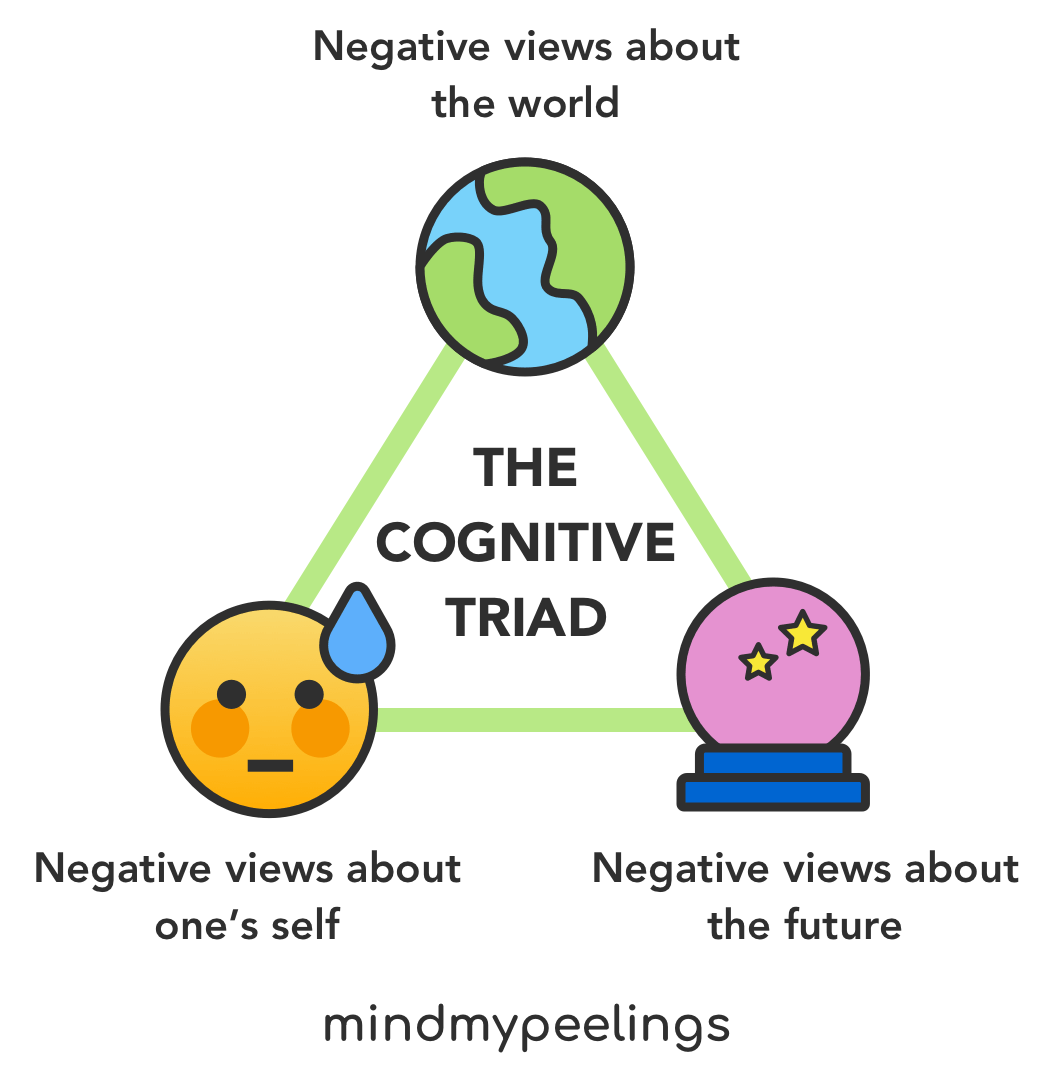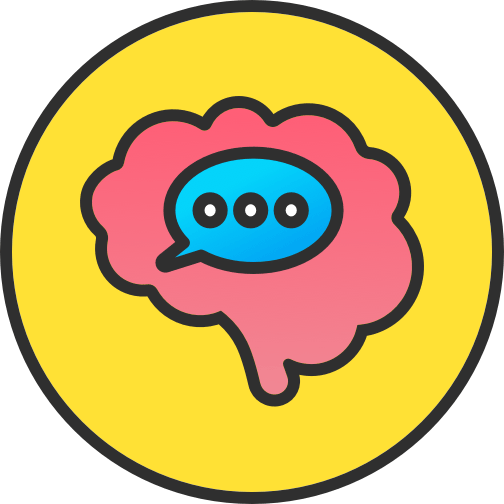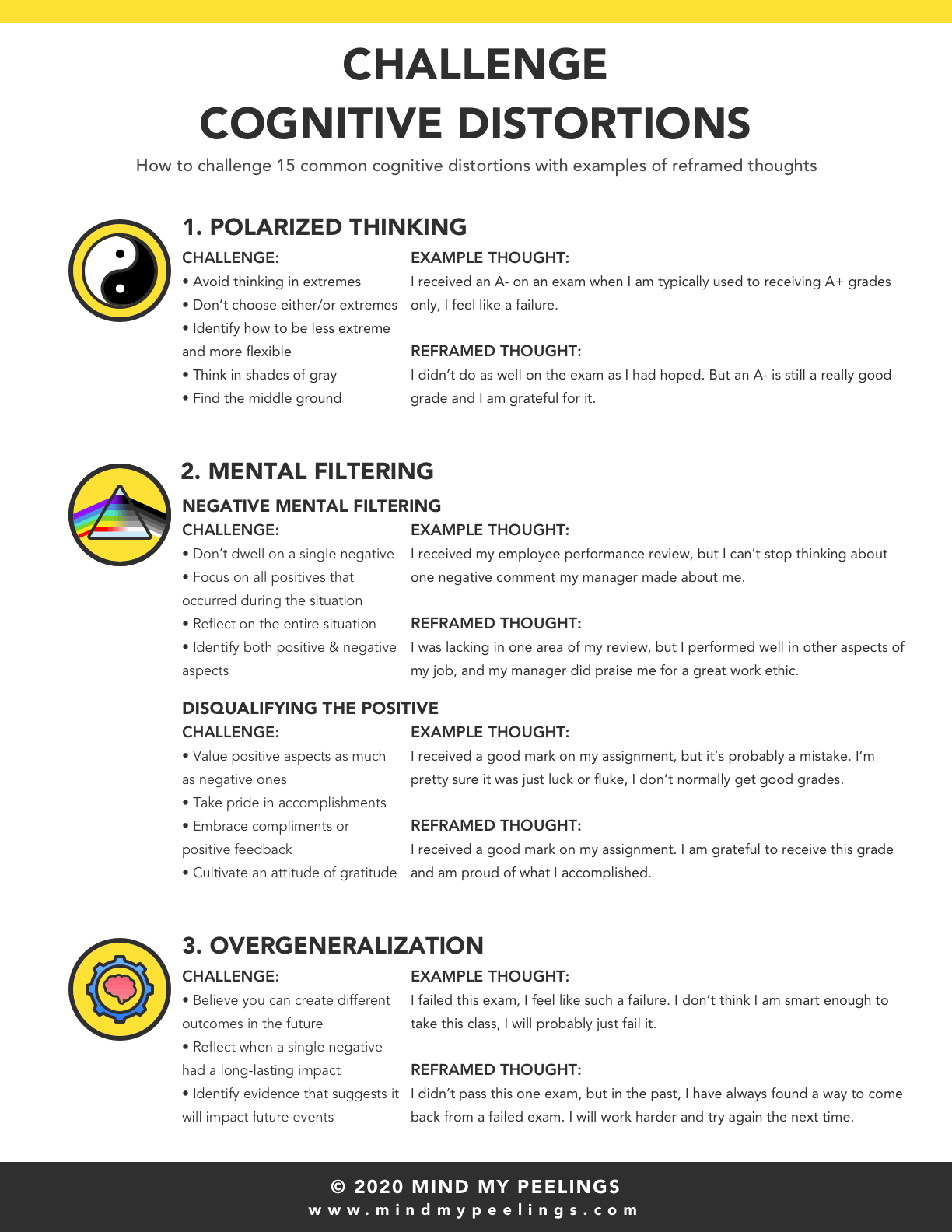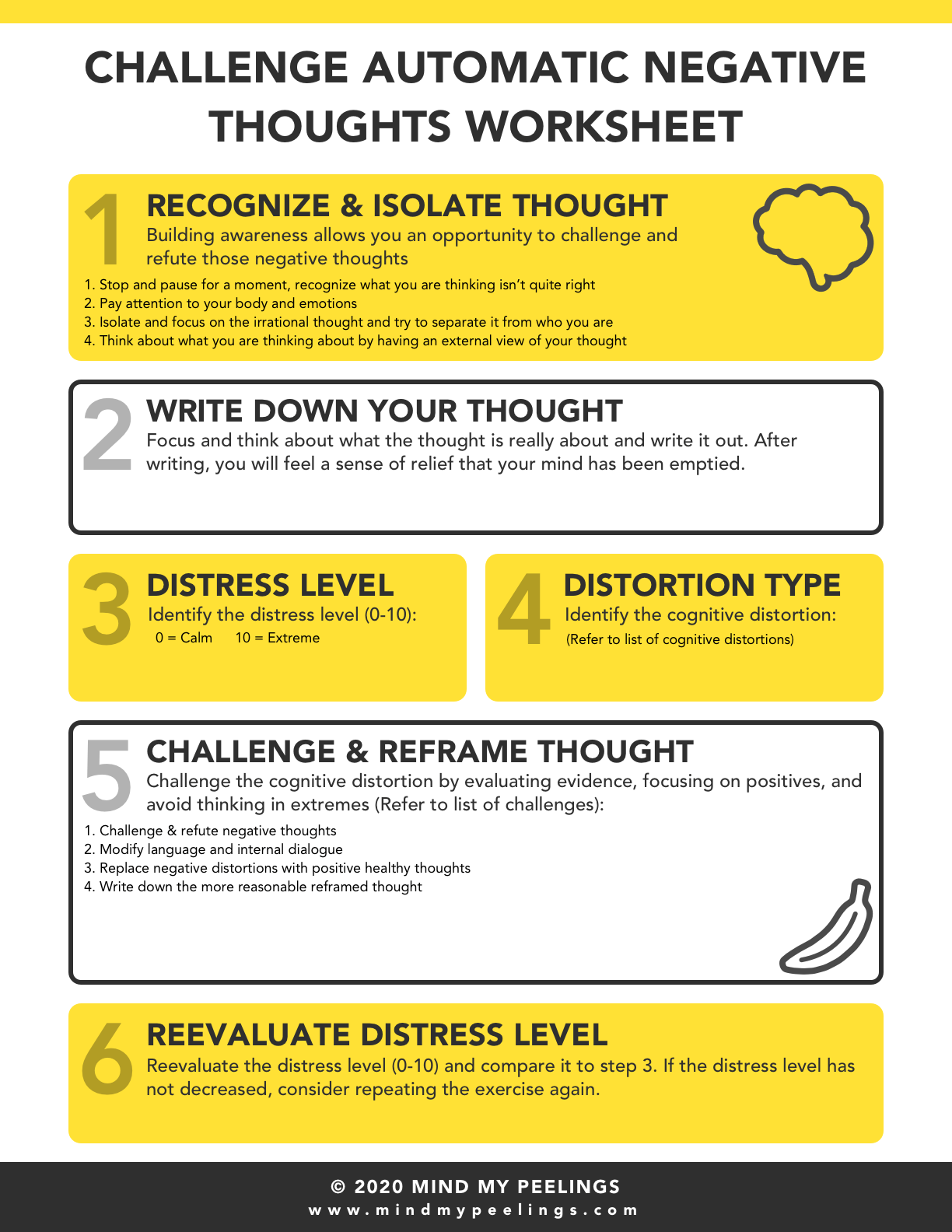How to Stop Negative Thoughts
Automatic negative thoughts influence emotions and distort our perception of reality in a negative way. These thoughts are difficult to recognize because they are fleeting and habitual.
Negative thoughts can make us feel agitated, anxious, be less productive, cause harm to our relationships, or cause psychological damage.
There is a simple way to overcome negative automatic thinking by challenging and reframing the thoughts in a positive way.
Understanding Automatic Negative Thoughts
Most of our thoughts occur automatically. This is good for doing daily general tasks such as brushing your teeth, eating a meal, getting dressed.
However, it can be a bad thing because it is habitual and automatic since we do not pay much attention to it.
It is important to understand how automatic negative thoughts occur and how they affect us so we can be prepared to challenge them.
What Are Automatic Negative Thoughts
Automatic Negative Thoughts (ANTs) are negative beliefs that occur habitually. They are involuntary responses to certain situations that are based on core beliefs you hold about yourself, others, or the world.
ANTs can lead to self-doubt, anger, irritability, depression, and anxiety. They have a strong influence on our mood and the difference between accepting or ignoring them will impact how happy our lives could be.
You cannot directly control these automatic thoughts. But you can indirectly alter your beliefs in a positive way.
It is important to recognize that all automatic negative thoughts are:
Always negative
Makes you feel bad about yourself
Self-sabotaging and tend to stop you from helping yourself
Uninvited and judging you when you least expect it
Believable because you are stuck in a negative thinking trap
Biased because you are experiencing a distorted perception of reality
Aaron Beck’s Cognitive Triad
The automatic negative thoughts are categorized into three perspectives of one’s belief. This was first proposed by Aaron Beck in 1976 and is known as the Negative Triad.
The triad involves automatic, uncontrollable negative thoughts about:
1. One’s Self: “I’m worthless and hate myself”
2. The World or Environment: “Why does no one care about me”
3. The Future: “Thing’s will never get better”
Why Do I Have Negative Thoughts
It is completely normal to experience both positive and negative thoughts daily. So you can stop worrying, it’s okay to have negative thoughts.
Negative thoughts are an evolutionary trait to help keep you safe. It is meant to identify threats, learn from mistakes, and solve problems.
90% of all thoughts are repetitive. And if you repeat something often enough, it creates a neural pathway in the brain. So if your negative thoughts get repeated enough, they become habitual.
Effects of Negative Thinking
Negative thinking is normal and is there to keep you safe. However, when you have a negative experience, your brain will remember it.
The next time you have a similar experience, your brain triggers a response thinking it is being threatened. This negative response is what makes you feel agitated, angry, depressed, or even anxious.
It can trigger a downward spiral which leads to a cycle of negative thoughts, emotions, and unhelpful behaviors. Thankfully, there is a simple 6 step process for challenging automatic negative thoughts.
How to Stop Negative Thinking in 6 Steps
Negative Automatic Thoughts affect many of us due to our habitual tendency towards irrational thinking patterns.
This Cognitive Behavioral Therapy technique can be achieved in 6 steps by reframing negative thoughts and over time your thoughts will be replaced with more rational thinking.
Recognize and Isolate the Thought
Write Down the Thought
Identify the Distress Level
Identify the Cognitive Distortion
Challenge & Reframe Your Thoughts
Reevaluate the Distress Level
1. Recognize and Isolate the Thought
Recognizing that you are experiencing a thinking error is a very important first step. This provides an awareness that allows you an opportunity to challenge and refute those thoughts.
When you experience an automatic negative thought:
pause for a moment
try and recognize what you are thinking isn’t quite right
isolate and focus on that irrational thought
recognize how it makes you feel
Try to separate the thought from who you are. Think about what you are thinking about. Once you have an external view of your thought you have an opportunity to try to refute it.
This is known as Metacognition and occurs when your brain realizes, “Wait my thinking isn’t quite right.” It is a deeper level of thinking that allows you to think about what you are thinking.
This awareness provides an opportunity to allow you to understand, adapt, change, control, and use your thought process in a positive and healthy way.
2. Write Down Your Thought
Writing down your though might seem like a really simple step. But it is much more complex and beneficial than you realize.
When you are experiencing an automatic negative thought, it can be difficult to pull yourself out of the thinking trap and write down what you are thinking about.
Writing your thought enables you to have that higher level of thinking because you have to focus and think about what the thought was really about. This is again the metacognition mentioned previously.
Writing helps you process your thoughts and emotions by:
clearing your thoughts and unloading all your emotions
giving you clarity and focus to process your feelings
creating positive self-dialogue with your mind
reducing stress and increases gratitude
When you are finished writing you will feel a sense a relief that your mind has been emptied of that clutter. This will give you a sense of a clearer picture of what really happened because your mind can use that free space to focus.
If you would like to learn how writing can help process your thoughts and emotions, check out our guide here.
3. Identify the Distress Level
Identify the distress level your automatic thoughts make you feel. This will help rank the severity the negative thought is causing you.
The distress level is ranked between 0 and 10. Zero meaning you are calm and peaceful with no distress at all. Ten means that the distress is at its extreme and is paralyzing.
Rank the distress level based on how you feel; consider your emotions and any physical distress you may experience.
4. Identify the Cognitive Distortion
Cognitive distortions are common thinking patterns that influence irrational negative thoughts and feelings. These negative thinking traps cause a distorted perception of reality in an inaccurate way.
There are 15 common cognitive distortions that most people will experience. These styles of distorted thinking influence our thoughts in different ways.
Go through the list of cognitive distortions and identify the one that applies to your negative automatic thought. I recommend printing out a copy so you have it ready when you need it.
If you have difficulty identifying the correct one, here are examples of each cognitive distortion to help you better understand them.
5. Challenge & Reframe Negative Thinking
Challenging cognitive distortions can be accomplished by evaluating the evidence, focusing on positive thoughts, and avoid thinking in extremes.
Each of the distorted thinking styles requires a unique solution to overcome negative thinking.
You can overcome negative thoughts by:
Challenging and refuting negative thoughts
Modifying our language and internal dialogue
Replacing negative distortions with positive healthy thoughts
Writing down the more reasonable reframed thought
How to challenge each of the cognitive distortions is explained below. Examples of reframing negative thoughts for each distortion is provided. This will help you understand how to reframe your negative thoughts.
6. Reevaluate the Distress Level
After you have challenged and reframed the distorted thought, reevaluate the distress level to see if this exercise has helped.
If your distress level has decreased and you are feeling better emotionally and physically after the exercise, then you have successfully altered your negative thought.
If you don’t feel like your distorted thought has been corrected you can repeat the exercise again.
You may not always be able to correct your thinking, but with practice, you will be able to automatically recognize the negative thinking traps while altering your mindset from negative to positive.
Print out a free copy of the worksheet at the end of the article and start challenging your automatic negative thinking!
How to Challenging & Reframe Cognitive Distortions
Each distortion alters your perception of reality in different ways. It makes it difficult to challenge when you are not aware it is happening.
To make it easy for you, we have put together a list of the 15 cognitive distortions and how to challenge each one of them with examples of reframing statements. There is also a printable infographic if you prefer.
1. Polarized Thinking
Distortion: When you have an “All or Nothing” thinking pattern. There is a desire to be perfect, otherwise a complete failure.
Challenge: Avoid thinking in extremes (black or white). You don’t need to choose either/or extremes that are presented to you. Identify how you can be less extreme or what you can do to be more flexible. Try to think in shades of gray and identify the middle ground.
Example Thought: I received an A- on an exam when I am typically used to receiving A+ grades only, I feel like a failure.
Reframed Thought: I didn’t do as well on the exam as I had hoped. But an A- is still a really good grade and I am grateful for it.
2. Mental Filtering
Negative Mental Filtering
Distortion: When a person filters out positives, magnifies negative details, and dwells on those feelings.
Challenge: It is easy to get caught up in a single negative aspect of your thoughts. Focus on all the positives that occurred during the situation. Reflect on the entire situation and try to identify not only the negative aspects but the positive ones as well.
Example Thought: I received my employee performance review but I can’t stop thinking about one negative comment my manager made about me.
Reframed Thought: Although I was lacking in one area of my performance review, I performed well in other aspects of my job and my manager did praise me for my great work ethic.
Disqualifying the Positive
Distortion: Acknowledges the positive experiences but refuses to accept it. Invalidates and ignores the positives while finding excuses to turn it into a negative one.
Challenge: Value the positive aspects as much as you value the negative aspects. Take pride in your accomplishments. Embrace any compliments or positive feedback you received no matter how small it may seem; cultivate an attitude of gratitude.
Example Thought: I received a good mark on my assignment, but it’s probably a mistake. I’m pretty sure it was just luck or fluke, I don’t normally get good grades.
Reframed Thought: I received a good mark on my assignment. I am grateful to receive this grade and am proud of what I accomplished.
3. Overgeneralization
Distortion: Focusing on a single event that has occurred and incorrectly concluding all similar events going forward will result in the same failure or negative experience.
Challenge: Take that single negative event and believe you can create a different outcome in the future. Reflect on times where a single negative had a long-lasting outcome as you are expecting this one will. Identify any evidence that suggests this single negative event will impact all future events.
Example Thought: I failed this exam, I feel like such a failure. I don’t think I am smart enough to take this class, I will probably just fail it.
Reframed Thought: I didn’t pass this one exam, but in the past, I have always found a way to come back from a failed exam. I will work harder and try again the next time.
4. Jumping to Conclusions
Mind Reading
Distortion: Knowing what the other person is thinking. Assumptions of reasons or intentions are taken as the only valid reasoning.
Challenge: Ask yourself if you are sure you actually know what someone is thinking. Investigate your assumptions and try to identify logical reasons, based on evidence, that may have contributed to the situation that has occurred.
Example Thought: I visit a friend, but her expression seems negative towards me. She doesn’t want to see me and goes into her bedroom. She claimed she was sick but I feel like she is avoiding me.
Reframed Thought: She could really be sick and just wants to rest. There are many reasons why she wouldn’t want to see me, such as being self-conscious about her appearance or even worried she might be contagious.
Fortune Telling
Distortion: Making conclusions and predictions based on little or no evidence. Predictions are generally arbitrary and have negative outcomes.
Challenge: Ask yourself how do you know what will actually happen. Is there any evidence to suggest that what you think will occur will actually happen? Think about how often you have been accurate with your predictions in the past.
Example Thought: I’m going to have a bad day today.
Reframed Thought: Today may have some challenges, but I will overcome them and have a good day.
5. Catastrophizing
Magnification
Distortion: An over-exaggeration of a thought which leads to worries escalating quickly and becoming the worst-case scenario.
Challenge: Take the negative event for what it is. Don’t try to make it any more than it is. Reframe the situation by looking at opportunities rather than the catastrophic event you make it out to be.
Example Thought: There is a lot of traffic on my way to work and I’m never going to get there on time.
Reframed Thought: I may be late but I will get there safely, in the meantime I can enjoy the radio.
Minimization
Distortion: Minimizing positive experiences. The importance of positive qualities is diminished.
Challenge: Take the positive experience for what it is. Try not to diminish the importance by focusing on the positive qualities rather than turning it into a negative. Embrace the positive experience and take pride in your accomplishments.
Example Thought: As an athlete, I win an award but it doesn’t seem like I accomplished much as others have already won this award.
Reframed Thought: I won an award, I am proud of what I accomplished and grateful for how far I have come in my athletic career.
6. Personalization
Distortion: Takes things personally which causes a direct and personal reaction to everything others do or say even if unrelated to them.
Challenge: Identify why you feel responsible and determine if it was really in your control. Acknowledge that things are rarely one person’s fault. Brainstorm logical reasons rather than unnecessarily blaming yourself if you feel excluded or targeted. Look at things from an outsider’s perspective.
Example Thought: My partner and I show up late to a dinner party at a friend’s. When we arrived, it seemed like everyone was mad and not having a good time because we showed up late. I should have made us leave earlier so this wouldn’t have happened.
Reframed Thought: Even though we were late to the dinner party, I cannot control how people feel if they aren’t having a good time. There could be other factors that contributed to people not enjoying the party before I arrived.
7. Blaming
Distortion: Blames others and plays a victim role while holding others responsible for their pain.
Challenge: Avoid playing a victim role by trying to see the situation from the other person’s perspective. Recognize that blame does not always fall on one person’s shoulders. Take responsibility and apologize for any role you may have played in the situation. Identify solutions and move forward as best you can. Practice empathy and focus on understanding the other person. Picture yourself walking in their shoes and get rid of the right-wrong mentality.
Example Thought: I blame my significant other for the relationship issues we experienced. Why am I always treated this way, only if they put more effort into our relationship.
Reframed Thought: A relationship takes two people to make it work. I am equally responsible for any issues we may have. I should apologize for my mistakes and try to move forward as best we can.
8. Labeling
Distortion: Assign judgment to yourself or others solely based on one negative incident. The label is generally exaggerated.
Challenge: Remember labels are a result of an error or mistake. Attribute the error to the event instead of yourself or others. One failed attempt does define you, separate these from the negative labels. Remind yourself that nobody is just one thing.
Example Thought: Someone at work made a mistake that had severe consequences for other tasks including the ones I am working on. Why are they so stupid for making those mistakes, now I have to redo everything.
Reframed Thought: I understand that mistakes can happen to any of us. Unfortunately, this mistake occurred. We will have to spend some extra effort to fix it, but it is not the end of the world. They made a mistake and I know they are capable of doing a better job next time.
9. Always Being Right
Distortion: Always having the need to be right. Internalize opinions as facts and will put others on trial to prove they are correct.
Challenge: Understand that it is acceptable to be wrong sometimes. Nobody is perfect and gets everything right all the time. You are allowed to make mistakes. Be open-minded to other’s suggestions. Try and identify if your thoughts are facts or actually opinions.
Example Thought: At work, I didn’t agree with the way a task was being performed by a colleague. I told them the right way to do it and I don’t know why they wouldn’t listen to me. I know I am right and it should be done my way.
Reframed Thought: Maybe my way isn’t the best way to perform the task. I don’t really know which method is better until I try it for myself. Maybe we can go with their method this time and see how it works out.
10. Should Statements
Distortion: “Should” do, “must” do, or even “shouldn’t” do statements. The statements are rules enforced on themselves or others.
Challenge: Identify how the “should” statements make you feel. These statements should be motivating rather than making you feel conflicted or even paralyzed. Try to use the word prefer in place of should.
Example Thought: I should stop being lazy and exercise today.
Reframed Thought: I would prefer to exercise today. But I’m not feeling up for it today. If I don’t exercise today, I can exercise the next day.
11. Emotional Reasoning
Distortion: Any feeling must be true. The emotion is accepted as fact because all logical reasoning is blocked out.
Challenge: Let yourself feel your emotions but don’t let it consume you. Be mindful of your emotions without judgment. Remember emotions can change quickly. Avoid letting your emotion transform into truths. Challenge the validity of what you are feeling and identify whether it is based on emotions or facts.
Example Thought: I feel alone and uncared for because my partner does not want to spend time with me and instead is working overtime.
Reframed Thought: My partner is working overtime because they are busy at work. Not because they do not care for me. Usually, when they are not busy they will spend time with me.
12. Control Fallacy
External Control Fallacy
Distortion: Life is completely controlled by external factors and fate has already been decided.
Challenge: Look for opportunities in small changes before making big changes. Recognize you may not be able to control everything that goes on in your life. Understand you can still control personal decisions that may have an effect on others around you. Identify things that are in your control and things that are out of your control.
Example Thought: I feel overwhelmed and anxious due to the coronavirus pandemic. I feel like I have no control to protect myself or my family from the virus.
Reframed Thought: I recognize that I cannot control how the virus spreads but I can reduce the risks by protecting myself with the necessary protective equipment, such as face masks and washing my hands regularly.
Internal Control Fallacy
Distortion: Has complete control of themselves and their surroundings. Feels responsible for the pain and happiness of others.
Challenge: Recognize that you cannot control everything that goes on around you. Think about whether your actions actually contributed to the situation that occurred. Is there someone else in the situation that needs to take responsibility for their own behavior or choices?
Example Thought: My daughter failed her exam. I blame myself because I should have spent more time helping her study.
Reframed Thought: Maybe she failed her exam because it was really difficult, not because I am a bad parent. I can offer to help her study next time, but it is her decision to put more effort into her studies.
13. Fallacy of Change
Distortion: Others should change to suit your own interests. Pressure's others to change because they feel the change will bring them happiness.
Challenge: Try to recognize that no one is responsible for your own happiness. Separate the change from your own happiness. Your happiness depends on yourself and the decisions or actions you make.
Example Thought: I feel my partner is perfect in every other way except these few minor things. If I make them change those things, it will make me so happy.
Reframed Thought: I can suggest those changes to my partner, but I understand that it is not necessary to make me happy. If they choose not to change I will still be happy with the way they are.
14. Fallacy of Fairness
Distortion: All things in life should be applied and measured based on fairness and equality.
Challenge: State your feelings as a preference rather than an expectation. Try to identify that you may not have control over the situation. Consider other factors you are unaware of that may have influenced the situation. Be grateful for what you do have and not what you don’t have.
Example Thought: A friend of mine makes a lot more money at their job doing something similar to me. Why don’t I make the same amount, it’s not fair they get paid more.
Reframed Thought: I might not make as much money as my friend, but I am grateful for the job I have. There could be many reasons why I don’t make as much such as the company I work for doesn’t generate as much profit.
15. Heaven’s Reward Fallacy
Distortion: If we lived in a fair world we would be rewarded fairly. Should be rewarded based on how much you sacrificed.
Challenge: Recognize that not every sacrifice you make will be rewarded as life isn’t always fair. Change your feelings as a preference rather than an expectation and separate it from the sacrifice. Consider whether your sacrifice is the only factor that may have played a role in being rewarded.
Example Thought: A colleague was promoted over me, but I believe I worked harder and deserved that promotion.
Reframed Thought: It would have been nice to get that promotion, but I don’t always have control over other's decisions. Perhaps I can make my boss aware of all the effort and hard work I have been putting into my job and maybe I will be considered next time.
What to Do When You Have Negative Thoughts
Start challenging negative thoughts by:
Printing a copy and familiarizing yourself with the list of distortions and challenges
Printing a copy of the automatic negative thoughts worksheet
When you experience a negative thought go through the ANTs worksheet
Keep practicing to shift your thinking towards more healthy thoughts
Cognitive Distortion Challenges Infographic
Download a printable pdf copy of the list of challenges for each of the cognitive distortions for the next time you experience a distorted thought.
Challenging Automatic Negative Thoughts Worksheet
Download a free printable pdf copy of the worksheet and start challenging and reframing automatic negative thoughts.
Go through the worksheet each time you experience a negative thought and refer to the list of distortions if you need to.
This will help you get rid of negative thoughts and shift your thinking patterns towards a positive relationship with your mind. It takes time and practice, so don’t be discouraged if you do not get it right away.





















